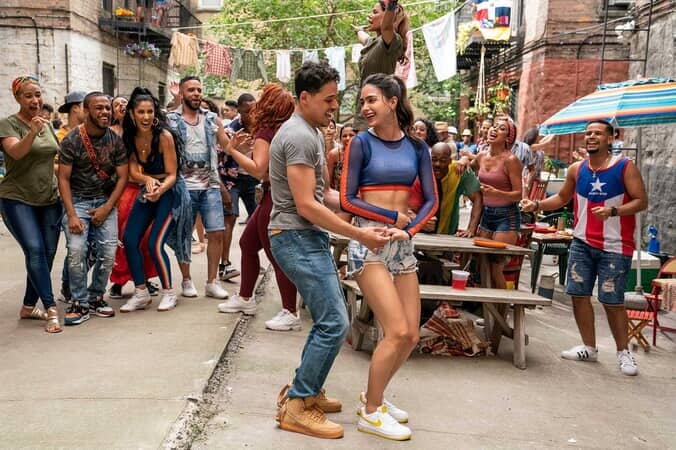Throughout modern movies and TV shows, there is a lot of representation for certain groups and much less for other groups. Being the largest minority in the United States, you would think that the media representation that surrounds Latino people would be positive and have a really firm grasp on what it truly means to be from this community.
Unfortunately, much of the media that is released today, whether it be movies or TV shows, paints Latino culture as something that it is not. Take AMC’s Breaking Bad for example. Besides one or two characters, every Latino that is portrayed on screen is quite literally involved with the drug cartel.

Image courtesy of Warner Brothers.
More recently, there have been huge strides in the representation of Latinos. In the Heights is a musical dramatic film that portrays the culture of the Washington Heights neighborhood of New York City. The film follows the story of Usnavi de la Vega, a bodega owner who immigrated to the United States from the Dominican Republic when he was a young boy.
The Washington Heights neighborhood is more than 60% Latino, which can be seen very well throughout the movie, featuring an almost 100% Latino cast.
One of the major aspects of Latino culture that comes up throughout the movie is the concept of Latinidad: the notion that there is shared culture between all Latin American people, despite differences in ethnicity, gender, or language.
After moving to California to attend Stanford University, the character of Nina Rosario felt alone. She had no community that she could share her experiences with. She even faced multiple acts of racism, such as when her roommate assumed that Nina was stealing from her. Or the girl who thought Nina was a service worker, ironically, at a diversity dinner. This ultimately led to Nina wanting to withdraw from the university. Without a sense of Latinidad, she did not feel welcome or wanted at Stanford.
The night the community’s matriarch, the Cuban grandmother Claudia, passes away, the power goes out in the neighborhood. The next day, Daniela, a Puerto Rican hair stylist, reenergizes the community by appealing to their Latinidad wondering “since when are Latin people scared of heat!”
The song for this scene deals with acknowledging your culture, and moving through the difficult times of life. The song and the scene ended with the main characters recognizing what it means to have Latinidad. The symbolic electrical power eventually ends up returning to Washington Heights.
When Gentrification Comes to Your ‘Hood
Maintaining a sense of Latinidad only scratches at the surface of the issues that are highlighted in In the Heights. A significant plot-line is the gentrification of the neighborhood.
Business owner Kevin Rosario owns a local Taxi dispatch service that he bought after immigrating to the United States from Puerto Rico. Being the father of the previously mentioned Nina, Kevin has had to make some hard decisions in regards to his business. In order to pay for Nina’s education and rising prices of everything else, Kevin ended up selling half of his business to an outsider from Washington Heights.
Another big musical performance in the film was the reading of the lottery ticket. While at the community pool, the locals begin to sing about what they would do if they were to win the $96,000 jackpot. All those featured said they would use some of the money for themselves, and use the rest to better the community, or help out community members.
There is so much that makes this movie great from the standpoint of Latino representation. From incorporating aspects of Latinidad and gentrification, to the complicated subject of machismo – also worthy of exploration, – this movie showcases a deep understanding of what it means to be Latino in the U.S.
Getting back quickly to machismo and it’s counterpart, marianismo. In almost all of the musical arrangements, it seems as though the softer, more melodic songs are sung by the female characters. In contrast the men are sometimes rapping in other parts of the same piece. This seems a little problematic.
When you have primarily women singing softer more melodic songs, it gives the audience the impression that the person singing is weak. The syncopation of rap can come off as aggressive, and makes it a style that people perceive only men can primarily partake in. Whenever there was a rapping section, it was almost always a man.
While you can argue that Lin Manuel Miranda, the creator of the award-winning Tony musical adapted for the screen, composed the songs in this manner with no malice in mind, in his other works, like Hamilton, he does have quite a few women rapping.
Regardless, this movie does a good job of giving an underrepresented community the representation that they need. Abuela Claudia’s dialogue from early on in the movie delivers a take home message that can resonate with all Latinos: “It’s the little details that tell the world we are not invisible.”
Patrick McNabb, a senior journalism major at the Reynolds School of Journalism at the University of Nevada, Reno contributed this article to Noticiero Móvil.
This commentary is part of the “Latinos in the Eyes of the Media” special series. In this section, Noticiero Móvil publishes pieces by UNR students that dive into films and television shows in which Latino characters, culture and norms are portrayed. The goal is to explore and illuminate how a lack of Latino representation in the media continues to promote some of the discriminatory and stereotypical practices that affect Latinos to this day in the U.S.
